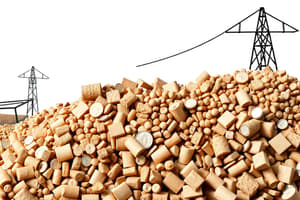Podcast
Questions and Answers
What condition must be met for long run macroeconomic equilibrium to occur?
What condition must be met for long run macroeconomic equilibrium to occur?
- Real GDP demanded is greater than Real GDP supplied
- AD curve is below the LAS curve
- Real GDP demanded equals Real GDP supplied (correct)
- The price level is increasing indefinitely
At what point does long run macroeconomic equilibrium occur on a graph?
At what point does long run macroeconomic equilibrium occur on a graph?
- At the intersection of the AD and SRAS curves
- At the highest point on the LAS curve
- At the intersection of the AD and LAS curves (correct)
- Where the AD curve shifts to the right
Which of the following statements is true regarding the LAS curve?
Which of the following statements is true regarding the LAS curve?
- It fluctuates based on demand shifts
- It remains vertical in the long run (correct)
- It is downward sloping
- It represents short-term equilibrium
Which scenario indicates a deviation from long run macroeconomic equilibrium?
Which scenario indicates a deviation from long run macroeconomic equilibrium?
What can cause a shift in the Aggregate Demand (AD) curve leading to a new long run equilibrium?
What can cause a shift in the Aggregate Demand (AD) curve leading to a new long run equilibrium?
What is the primary focus of Real GDP when comparing production levels over time?
What is the primary focus of Real GDP when comparing production levels over time?
Which factor does NOT directly influence Long Run Aggregate Supply?
Which factor does NOT directly influence Long Run Aggregate Supply?
How does the quantity of Real GDP supplied typically respond to changes in price level?
How does the quantity of Real GDP supplied typically respond to changes in price level?
In the long run, what primarily remains unchanged despite fluctuations in the price level?
In the long run, what primarily remains unchanged despite fluctuations in the price level?
What defines the concept of 'potential GDP'?
What defines the concept of 'potential GDP'?
What is NOT a determinant of Aggregate Supply in the long run?
What is NOT a determinant of Aggregate Supply in the long run?
What happens to the quantity of Real GDP supplied when wages and prices increase at the same rate?
What happens to the quantity of Real GDP supplied when wages and prices increase at the same rate?
Which aspect does Aggregate Demand primarily focus on?
Which aspect does Aggregate Demand primarily focus on?
What is one effect of lowering taxes on the economy?
What is one effect of lowering taxes on the economy?
How does an increase in government expenditure affect aggregate demand?
How does an increase in government expenditure affect aggregate demand?
What happens when interest rates are increased?
What happens when interest rates are increased?
What is the result of a fall in the foreign exchange rate for domestic goods?
What is the result of a fall in the foreign exchange rate for domestic goods?
How does an increase in foreign incomes affect aggregate demand for a country's exports?
How does an increase in foreign incomes affect aggregate demand for a country's exports?
What occurs if Real GDP is above Equilibrium GDP?
What occurs if Real GDP is above Equilibrium GDP?
Which of the following is a primary purpose of monetary policy?
Which of the following is a primary purpose of monetary policy?
What is the likely effect of increasing the quantity of money in the economy?
What is the likely effect of increasing the quantity of money in the economy?
If Canadian goods become cheaper for Americans due to changes in the foreign exchange rate, what is a likely outcome?
If Canadian goods become cheaper for Americans due to changes in the foreign exchange rate, what is a likely outcome?
What can be concluded if the intersection of the AD curve and SAS curve represents short-run equilibrium?
What can be concluded if the intersection of the AD curve and SAS curve represents short-run equilibrium?
What typically happens if the government cuts interest rates?
What typically happens if the government cuts interest rates?
What is a potential consequence of too much money in the economy?
What is a potential consequence of too much money in the economy?
During a recession, which fiscal policy would most likely be implemented to stimulate the economy?
During a recession, which fiscal policy would most likely be implemented to stimulate the economy?
How does a higher foreign income impact aggregate demand for domestic goods?
How does a higher foreign income impact aggregate demand for domestic goods?
What happens to the quantity of Real GDP supplied when the price level increases, assuming no change in wages or other factors?
What happens to the quantity of Real GDP supplied when the price level increases, assuming no change in wages or other factors?
What does potential GDP represent in an economy?
What does potential GDP represent in an economy?
Which of the following would cause the short-run aggregate supply (SAS) curve to shift leftward?
Which of the following would cause the short-run aggregate supply (SAS) curve to shift leftward?
What effect does a decrease in the price level have on the quantity of Real GDP demanded?
What effect does a decrease in the price level have on the quantity of Real GDP demanded?
What is one reason that can increase aggregate demand?
What is one reason that can increase aggregate demand?
How do changes in the quantity of capital affect potential GDP?
How do changes in the quantity of capital affect potential GDP?
What does a leftward shift in the short-run aggregate supply curve typically indicate?
What does a leftward shift in the short-run aggregate supply curve typically indicate?
Which of the following best describes the wealth effect?
Which of the following best describes the wealth effect?
Which of the following factors does NOT typically influence aggregate demand?
Which of the following factors does NOT typically influence aggregate demand?
What does the aggregate demand curve illustrate?
What does the aggregate demand curve illustrate?
Why would an increase in technology typically shift the aggregate supply curve?
Why would an increase in technology typically shift the aggregate supply curve?
Under what conditions is Real GDP said to be less than potential GDP?
Under what conditions is Real GDP said to be less than potential GDP?
What typically occurs to the aggregate demand if there is an expectation of future inflation?
What typically occurs to the aggregate demand if there is an expectation of future inflation?
If money wage rates increase, what is the short-term effect on the short-run aggregate supply curve?
If money wage rates increase, what is the short-term effect on the short-run aggregate supply curve?
Flashcards
Short Run Aggregate Supply (SAS)
Short Run Aggregate Supply (SAS)
The total quantity of goods and services that all firms in the economy are willing and able to produce at each price level in a given time period.
Potential GDP
Potential GDP
The amount of goods and services that an economy can produce when all resources are fully employed. It represents the maximum potential output.
Equilibrium Price Level
Equilibrium Price Level
The price level at which the Short Run Aggregate Supply (SAS) curve intersects the Long Run Aggregate Supply (LAS) curve. This is the point where the economy is producing at its potential GDP.
Short Run Aggregate Supply Curve
Short Run Aggregate Supply Curve
Signup and view all the flashcards
Aggregate Demand (AD)
Aggregate Demand (AD)
Signup and view all the flashcards
Aggregate Demand Curve
Aggregate Demand Curve
Signup and view all the flashcards
Long Run Equilibrium
Long Run Equilibrium
Signup and view all the flashcards
Increase in Short Run Aggregate Supply
Increase in Short Run Aggregate Supply
Signup and view all the flashcards
Decrease in Short Run Aggregate Supply
Decrease in Short Run Aggregate Supply
Signup and view all the flashcards
Aggregate Demand Shocks
Aggregate Demand Shocks
Signup and view all the flashcards
Wealth Effect
Wealth Effect
Signup and view all the flashcards
Intertemporal Substitution Effect
Intertemporal Substitution Effect
Signup and view all the flashcards
Fiscal Policy
Fiscal Policy
Signup and view all the flashcards
Monetary Policy
Monetary Policy
Signup and view all the flashcards
The World Economy
The World Economy
Signup and view all the flashcards
What is Real GDP?
What is Real GDP?
Signup and view all the flashcards
What is Aggregate Supply?
What is Aggregate Supply?
Signup and view all the flashcards
What is Long Run Aggregate Supply (LRAS)?
What is Long Run Aggregate Supply (LRAS)?
Signup and view all the flashcards
Why is LRAS vertical?
Why is LRAS vertical?
Signup and view all the flashcards
What determines the position of the LRAS curve?
What determines the position of the LRAS curve?
Signup and view all the flashcards
What happens to the quantity of real GDP supplied in the long run when the price level changes?
What happens to the quantity of real GDP supplied in the long run when the price level changes?
Signup and view all the flashcards
What is Nominal GDP?
What is Nominal GDP?
Signup and view all the flashcards
What is Aggregate Demand (AD)?
What is Aggregate Demand (AD)?
Signup and view all the flashcards
Changing Taxes (Fiscal Policy)
Changing Taxes (Fiscal Policy)
Signup and view all the flashcards
Transfer Payments (Fiscal Policy)
Transfer Payments (Fiscal Policy)
Signup and view all the flashcards
Government Spending (Fiscal Policy)
Government Spending (Fiscal Policy)
Signup and view all the flashcards
Interest Rates (Monetary Policy)
Interest Rates (Monetary Policy)
Signup and view all the flashcards
Money Supply (Monetary Policy)
Money Supply (Monetary Policy)
Signup and view all the flashcards
Foreign Exchange Rate Fall
Foreign Exchange Rate Fall
Signup and view all the flashcards
Aggregate Demand Increase (Foreign Exchange Rate)
Aggregate Demand Increase (Foreign Exchange Rate)
Signup and view all the flashcards
Foreign Income Increase
Foreign Income Increase
Signup and view all the flashcards
Aggregate Demand Increase (Foreign Income)
Aggregate Demand Increase (Foreign Income)
Signup and view all the flashcards
Real GDP
Real GDP
Signup and view all the flashcards
Short-Run Equilibrium GDP
Short-Run Equilibrium GDP
Signup and view all the flashcards
Short-Run Aggregate Supply (SAS) Curve
Short-Run Aggregate Supply (SAS) Curve
Signup and view all the flashcards
Short-Run Equilibrium
Short-Run Equilibrium
Signup and view all the flashcards
Long Run Macroeconomic Equilibrium
Long Run Macroeconomic Equilibrium
Signup and view all the flashcards
Long Run Aggregate Supply (LAS)
Long Run Aggregate Supply (LAS)
Signup and view all the flashcards
Equilibrium Point of AD and LAS
Equilibrium Point of AD and LAS
Signup and view all the flashcards
Full Employment Equilibrium
Full Employment Equilibrium
Signup and view all the flashcards
Study Notes
Aggregate Supply and Demand
- Real GDP is the total output of goods and services using base year prices (e.g., 2012). Nominal GDP, using today's prices, can look larger due to inflation. Real GDP only considers quantity produced.
- Aggregate real GDP supplied is the total output businesses are willing to produce at different price levels. Higher prices usually lead to increased production.
- Long Run Aggregate Supply (LRAS) represents the economy's maximum potential output when all resources are fully employed. It is unaffected by price level changes.
- Factors determining LRAS include labor, technology, and resource quality.
- Short-Run Aggregate Supply (SRAS) shows the relationship between the price level and the quantity of output supplied when the money wage rate and other factor prices are fixed. SRAS slopes upwards. A price level increase means firms are willing to sell more products because they will earn more money. A price decrease means firms make less output.
- Potential GDP is the output at full employment on the graph when SAS and LRAS meet. Real GDP is the actual output. If real GDP is lower than potential GDP, the economy is operating below its capacity.
Changes in Aggregate Supply
- Changes in aggregate supply result from factors other than price level.
- Changes in potential GDP shift both LRAS and SRAS. Potential GDP increases with more labor, capital, and/or advanced technology.
- An increase in the money wage rate shifts the SRAS curve leftward, reducing aggregate supply.
Aggregate Demand
- Aggregate demand (AD) curve shows the relationship between price level and the quantity of Real GDP demanded by all sectors of the economy. The AD curve slopes downward.
- Factors influencing AD include wealth effect, substitution effect, expectations, fiscal policy, monetary policy, and the world economy.
- The quantity demanded is the sum of consumption, investment, government expenditure, and net exports (exports - imports).
Why the Aggregate Demand Curve Slopes Downward
- Wealth effect: A higher price level reduces real wealth and reduces consumption expenditure. A lower price level increases real wealth and increases consumption.
- Substitution effect: Intertemporal and international substitution effects influence the relationship between price level and quantity demanded.
Changes in Aggregate Demand
- Any factor that influences spending decisions (other than the price level) affects aggregate demand.
- Expectations: Increased expected future income boosts current consumption and demand. Higher expected inflation increases current demand.
- Fiscal policy: Government spending and taxation affect aggregate demand. Higher government spending or lower taxes increase disposable income which increases consumption, thus increasing AD.
- Monetary policy: Interest rate adjustments and money supply change consumer and business borrowing costs, influencing aggregate demand through consumption and investment. A lower interest rate increases aggregate demand. A higher money supply increases aggregate demand.
- The world economy: Foreign exchange rates and foreign incomes impact demand for domestic goods. A weaker currency (fall in exchange rate) will increase aggregate demand, while increased foreign incomes increase consumer spending on domestic products.
Equilibrium
- Short-run equilibrium occurs when the quantity of real GDP supplied equals the quantity of real GDP demanded. This is the intersection of the AD and SRAS curves.
- Long-run equilibrium happens when AD intersects LAS.
Studying That Suits You
Use AI to generate personalized quizzes and flashcards to suit your learning preferences.





